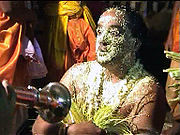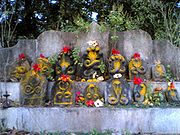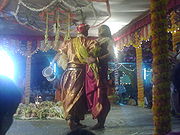
Nagaradhane
Encyclopedia




:ನಾಗಾರಾಧನೆ) is a form of snake worship
Snake worship
The worship of serpent deities is present in several old cultures, particularly in religion and mythology, where snakes were seen as entities of strength and renewal.-Hindu mythology:...
which, along with Bhuta Kola, is one of the unique traditions prevalent in coastal districts of Dakshina Kannada
Dakshina Kannada
- Geography :The district geography consists of sea shore in the west and Western Ghats in the east. The major rivers are Netravathi, Kumaradhara, Phalguni, Shambhavi, Nandini or Pavanje and Payaswini which all join Arabian sea. Vast areas of evergreen forests which once covered this district, have...
, Udupi and Kasaragod
Kasaragod district
Kasaragod District is one of the districts of the Indian state of Kerala. Kasaragod District was organised as a separate district on 24 May 1984...
alternatively known as Tulu Nadu
Tulu Nadu
Tulu Nadu is a Tulu-speaking region spread over to parts of present Karnataka and Kerala States of India. It consists of the Dakshina Kannada and Udupi districts of Karnataka and the northern parts of the Kasaragod district of Kerala up to the Payaswini River...
Origin of Nagaradhane
Snakes, especially the cobraCobra
Cobra is a venomous snake belonging to the family Elapidae. However, not all snakes commonly referred to as cobras are of the same genus, or even of the same family. The name is short for cobra capo or capa Snake, which is Portuguese for "snake with hood", or "hood-snake"...
have been revered from ancient times all over India. Due to their mysterious appearances and slithering movements, snakes had always been held in awe in India. Snakes find mention in famous religious epics like Mahabharata
Mahabharata
The Mahabharata is one of the two major Sanskrit epics of ancient India and Nepal, the other being the Ramayana. The epic is part of itihasa....
, Vishnu Purana
Vishnu Purana
The Vishnu Purana is a religious Hindu text and one of the eighteen Mahapuranas. It is considered one of the most important Puranas and has been given the name Puranaratna...
etc. Hindu Gods like Vishnu
Vishnu
Vishnu is the Supreme god in the Vaishnavite tradition of Hinduism. Smarta followers of Adi Shankara, among others, venerate Vishnu as one of the five primary forms of God....
and Shiva
Shiva
Shiva is a major Hindu deity, and is the destroyer god or transformer among the Trimurti, the Hindu Trinity of the primary aspects of the divine. God Shiva is a yogi who has notice of everything that happens in the world and is the main aspect of life. Yet one with great power lives a life of a...
have been associated with snakes. According to Hindu mythology, Lord Vishnu takes rest under the shade of the giant snake, Adisesha. Lord Shiva wears a snake vasuki
Vasuki
Vasuki is a Sanskrit name for a naga, one of the serpents of Buddhist and Hindu mythology. He is a great King of the nagas and has a gem on his head. Manasa, another naga, is his sister...
around his neck.
It is difficult to trace the origin of Nagaradhane, though the Bunts
Bunt (community)
Bunt , previously spelled Bant, are a community of erstwhile nobility, feudatory and gentry from the region of Tulu Nadu in the south west of India which comprises the districts of Udupi and Dakshina Kannada in the Indian state of Karnataka and Kasaragod taluk of Kerala...
of Tulu Nadu
Tulu Nadu
Tulu Nadu is a Tulu-speaking region spread over to parts of present Karnataka and Kerala States of India. It consists of the Dakshina Kannada and Udupi districts of Karnataka and the northern parts of the Kasaragod district of Kerala up to the Payaswini River...
claim to be kshatriyas
of Nagavanshi
Nagavanshi
The Nagavanshi dynasty is one of the ancient Kshatriya dynasties of India. The Vedas do not mention Kshatriyas of either Suryavanshi, Chandravanshi, Nagavanshi, Agnivanshi or such Vanshas or lineages. The Puranas, of debatable dating, constructed such genealogies. The Puranas were supposedly...
descent, thus maybe snake worship was popularised by them. Though most rituals of snake worship are done by brahmins, there is not a single Bunt
Bunt (community)
Bunt , previously spelled Bant, are a community of erstwhile nobility, feudatory and gentry from the region of Tulu Nadu in the south west of India which comprises the districts of Udupi and Dakshina Kannada in the Indian state of Karnataka and Kasaragod taluk of Kerala...
house that does not have a nagabana. Mostly, snakes were seen as a symbol of fertility. Elsewhere in India, snakes are worshiped during the Nagarapanchami Day. They are offered milk (research has shown that snakes are allergic to milk) and thilak is applied on their forehead.
The snake worship rituals practiced in Tulu Nadu
Tulu Nadu
Tulu Nadu is a Tulu-speaking region spread over to parts of present Karnataka and Kerala States of India. It consists of the Dakshina Kannada and Udupi districts of Karnataka and the northern parts of the Kasaragod district of Kerala up to the Payaswini River...
are quite unique and different from the other rituals. Snakes have their own snake shrines in a sacred grove known as Nagabana. The shrines have images of cobras carved of stones. Accordingly, nobody is allowed to chop the tree near the Nagabana. It is also believed that snakes, specifically the cobras, are not be harmed or killed by anyone. If harmed, the individual has to perform a ritual to cleanse the sin of killing or harming the snake. The belief is that the individual who refuses to perform the ritual will be cursed by the snake for eternity.
It can also be noted that in Tulu Nadu
Tulu Nadu
Tulu Nadu is a Tulu-speaking region spread over to parts of present Karnataka and Kerala States of India. It consists of the Dakshina Kannada and Udupi districts of Karnataka and the northern parts of the Kasaragod district of Kerala up to the Payaswini River...
or the South Canara region in Karnataka, agriculture is predominant that too paddy is the main crop. In these fields snakes help in saving the crop from rodents. This can be a plausible reason for worship of snakes in line with other nature worships such as cow and the banyan tree.
The ritual

Nagamandala depicts the divine union of male and female snakes. It is generally performed by two priests. The first priest, called as patri inhales the areca flower and becomes the male snake. The second priest, called as Nagakannika or the female snake dances and sings around an elaborate serpent design drawn with natural colours on the sacred ground. The ritual is supplemented by playing an hour glass shaped instrument called as Dakke. The drawings in five different colours on the sacred ground are white (white mud), red (mix of lime powder and turmeric powder), green (green leaves powder), yellow (turmeric powder) and black (roasted and powdered paddy husk).
Aashleshabali is similar nature to the after death rituals performed for the humans as per the Hindu
Hindu
Hindu refers to an identity associated with the philosophical, religious and cultural systems that are indigenous to the Indian subcontinent. As used in the Constitution of India, the word "Hindu" is also attributed to all persons professing any Indian religion...
tradition.
The ritual, centered around the serpent design, continues till early in the morning. A similar kind of ritual is found in Kerala and is known as Sarpam Thullal
Sarpam Thullal
Many ancient family houses in Kerala have special snake shrines called Kavu. Sarpam Thullal is usually performed in the courtyard of houses having snake shrines. This is a votive offering for family wealth and happiness. The dance is performed by members of a community called Pulluvar...
and Sarpam Kali. All communities of tulu nadu
Tulu Nadu
Tulu Nadu is a Tulu-speaking region spread over to parts of present Karnataka and Kerala States of India. It consists of the Dakshina Kannada and Udupi districts of Karnataka and the northern parts of the Kasaragod district of Kerala up to the Payaswini River...
revere snakes.
Significance of Nagabanas
Nagabanas or the sacred groves are deemed to be the resting place of the Snake God. Cutting of trees or defacing the grove is considered as sacrilege. People are wary of the wrath unleashed by the deity. Nagabanas once remained unspoilt and have contributed immensely to the preservation of valuable trees and medicinal plants in tulu naduTulu Nadu
Tulu Nadu is a Tulu-speaking region spread over to parts of present Karnataka and Kerala States of India. It consists of the Dakshina Kannada and Udupi districts of Karnataka and the northern parts of the Kasaragod district of Kerala up to the Payaswini River...
, but not now. With rapid and unplanned urbanisation many nagabanas have disappeared and in their place small temples for serpent god have been built clearing valuable trees and plants.

